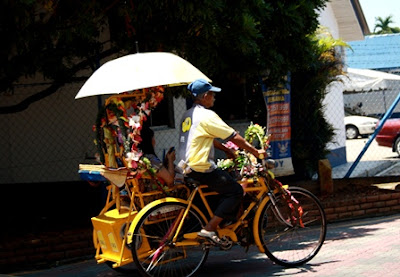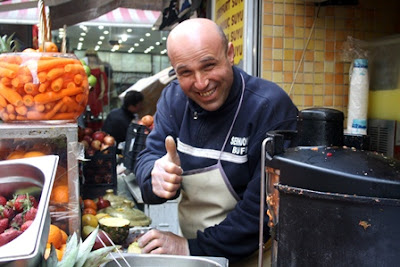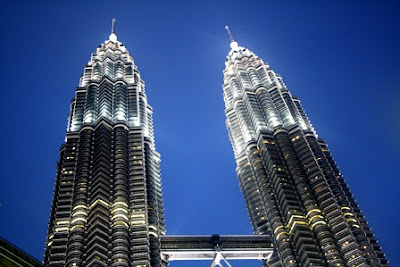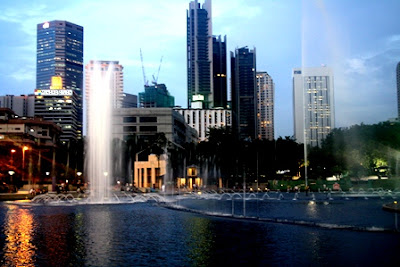One of the most famous bazaars in Istanbul is the Grand Bazaar- or known by the Turks as Kapali Cursi. The 15th century covered bazaar is one of the biggest and oldest in the world. It covers nearly 60 streets and contains about 4000 shops. It has 2 mosques, a police station, numerous restaurants and cafes. And I believe it sells almost anything you could want. Mind you I didn't buy anything from there, because I found the haggling and pushiness to be too much for me. As a good friend told hubby, the Grand Bazaar is simply for looking, not for buying. If you want to buy, you need to shop where the local shops. Nevertheless, if you are ever in Istanbul you have to visit the Grand Bazaar. It is an experience not be missed and you will need a few hours to meander though the maze of shops.
“Perhaps travel cannot prevent bigotry, but by demonstrating that all peoples cry, laugh, eat, worry, and die, it can introduce the idea that if we try and understand each other, we may even become friends.” Maya Angelou
Monday, May 2, 2011
Bustling Bazaars
I have been to a number of bazaars in Mecca and Medina, Malaysia, Vietnam and Thailand, so I wasn't expecting much. But the bazaars in Istanbul were amazing-bustling works of art. Every vendor showcases his or her wares as if they were things not to just to be sold, but were items to tantilise the five senses- sight, smell, taste, touch and hearing. Things were lined exactly; colours coordinated perfectly...It was an absolute delight to behold and experience as these pictures will show.
One of the most famous bazaars in Istanbul is the Grand Bazaar- or known by the Turks as Kapali Cursi. The 15th century covered bazaar is one of the biggest and oldest in the world. It covers nearly 60 streets and contains about 4000 shops. It has 2 mosques, a police station, numerous restaurants and cafes. And I believe it sells almost anything you could want. Mind you I didn't buy anything from there, because I found the haggling and pushiness to be too much for me. As a good friend told hubby, the Grand Bazaar is simply for looking, not for buying. If you want to buy, you need to shop where the local shops. Nevertheless, if you are ever in Istanbul you have to visit the Grand Bazaar. It is an experience not be missed and you will need a few hours to meander though the maze of shops.
One of the most famous bazaars in Istanbul is the Grand Bazaar- or known by the Turks as Kapali Cursi. The 15th century covered bazaar is one of the biggest and oldest in the world. It covers nearly 60 streets and contains about 4000 shops. It has 2 mosques, a police station, numerous restaurants and cafes. And I believe it sells almost anything you could want. Mind you I didn't buy anything from there, because I found the haggling and pushiness to be too much for me. As a good friend told hubby, the Grand Bazaar is simply for looking, not for buying. If you want to buy, you need to shop where the local shops. Nevertheless, if you are ever in Istanbul you have to visit the Grand Bazaar. It is an experience not be missed and you will need a few hours to meander though the maze of shops.
Monday, April 25, 2011
Majestic Istanbul
For so long I have wanted to come to Istanbul. I remember as a young adult reading about the great history, the beautiful, majestic mosques and the many ruins doting the city. And now I am here, finally.
H and I have been here for 4 days and tomorrow is our last day and honestly I don't want to leave. I wish we had more time to travel around Turkey, but unfortunately we need to move on to the third leg of our trip, Syria (yes I know- are we crazy with everything that is happening there atm?).
So four days here and hours of walking all day (and night), we have managed to cover most parts of Istanbul- old, new and Asia which included the historical sites, mosques, churches, fountains, palaces, ruins and museums.
And what a beautiful, splendid and majestic city. There is so much appreciation for culture, art and history here. It is breathtaking- every aspect of it.
While you can spend weeks here in Istanbul, we found 4 days to be perfect. Our itinerary included:
Day 1: The Sultanahmet Mosque (the Blue Mosque), the Turkish Islamic and Arts Museum, The Turkish Science Museum, the New Mosque and the Spice Bazaar.
Enough of my rambling- let's let the photos speak for Istanbul. Mind you, I took over 1500 photos, so this is only a snapshot of this breathtaking place.
H and I have been here for 4 days and tomorrow is our last day and honestly I don't want to leave. I wish we had more time to travel around Turkey, but unfortunately we need to move on to the third leg of our trip, Syria (yes I know- are we crazy with everything that is happening there atm?).
So four days here and hours of walking all day (and night), we have managed to cover most parts of Istanbul- old, new and Asia which included the historical sites, mosques, churches, fountains, palaces, ruins and museums.
And what a beautiful, splendid and majestic city. There is so much appreciation for culture, art and history here. It is breathtaking- every aspect of it.
While you can spend weeks here in Istanbul, we found 4 days to be perfect. Our itinerary included:
Day 1: The Sultanahmet Mosque (the Blue Mosque), the Turkish Islamic and Arts Museum, The Turkish Science Museum, the New Mosque and the Spice Bazaar.
Enough of my rambling- let's let the photos speak for Istanbul. Mind you, I took over 1500 photos, so this is only a snapshot of this breathtaking place.
 |
| Despite a very cold, wet morning there are still many eager visitors tot the Blue Mosque, including us |
 |
| Absolutely in awe of everything, like the intricate arches in the courtyard of the mosque |
 |
| We managed to perfom most of our prayers at the Blue Mosque. It was only a 5 minute walk from our hotel. |
The view from the park in the afternoon, with the sun struggling to come through after a very wet day.
 |
| A glimpse at the Blue Dome inside the Mosque |
 |
| The dilemma for me was that the mosque is so absolutely beautiful that I did not know where to start... |
 |
| A bit of Andaluscian influence can be seen throughout the Blue Mosque |
Museum of Turkish and Islamic Arts, near the Blue Mosque
 |
| The garden courtyard of the Museum |
 |
| Halim with his "book cover" |
Saturday, April 23, 2011
The Red City- Malacca
In the 4.5 years we lived in Malaysia and the countless times we have been back, we had never been to Malacca. So this trip around and to check out possibile places for H to take his students next year, we drove the 2.5 hours from KL. After getting lost a few times, we finally got there. If you are driving there by yourself folks, make sure you have a GPS, or better yet, bring along a Malaysia friend who knows their way around.
Malacca is a very significant historical city in Malaysia and is listed as a UNESCO World Heritage site since 2008. Malacca was a Malay sultanate until 1511 when it was conquered by the Portugese. Thereafter the Dutch took over in 1641 and finally it was colonised by the British in 1824. There was a brief occupation by the Japanese during World War 2 in 1942. Soon after it became part of the Malaya Union, which later became Malaysia.
Walking around Malacca, you can see the remants of this myraid history of colonisation. Walls have been added to the fort by successive occupiers and building architecture represents the cultures of the people at that time. Church roofs dot the skyline, along with mosque domes and minarets. And the faces of quite a number of Malaccans display the mixed race history.
So what is there to do in Malacca? Well, if you are a history and/or an architectural buff this is the place for you. There are the historical red shops and buildings lining the streets of Bandar Hilir. There are very old churches, such as the Christ Church in the middle of the square, temples and mosques. There are the really good museums; we went to the Malacca Sultanate one, which showcased, old Malaccan relics, scenes related to 'typical' Malaysia life, traditional Malaysia costumes, houses and even wedding celebrations among many other things.
If you fancy a cruise on the Malacca river, there are many boat operators around- I am told that the night cruise is breathtaking. If you prefer land, then there are many colourful trishaws around, waiting to take you around the city for a very reasonable price.
We were told shopping is also great in Malacca, but due to the very hot weather that day, we decided to give it a miss and head back to KL. But before we did that, we did get to enjoy great Malaccan food. Would I go to Malacca again? Yes, but this time with a guide. Though we managed alright on our own, it wuold have been more informative and significant if someone was able to show us exactly where to do and the significance of the places.
Malacca is a very significant historical city in Malaysia and is listed as a UNESCO World Heritage site since 2008. Malacca was a Malay sultanate until 1511 when it was conquered by the Portugese. Thereafter the Dutch took over in 1641 and finally it was colonised by the British in 1824. There was a brief occupation by the Japanese during World War 2 in 1942. Soon after it became part of the Malaya Union, which later became Malaysia.
Walking around Malacca, you can see the remants of this myraid history of colonisation. Walls have been added to the fort by successive occupiers and building architecture represents the cultures of the people at that time. Church roofs dot the skyline, along with mosque domes and minarets. And the faces of quite a number of Malaccans display the mixed race history.
So what is there to do in Malacca? Well, if you are a history and/or an architectural buff this is the place for you. There are the historical red shops and buildings lining the streets of Bandar Hilir. There are very old churches, such as the Christ Church in the middle of the square, temples and mosques. There are the really good museums; we went to the Malacca Sultanate one, which showcased, old Malaccan relics, scenes related to 'typical' Malaysia life, traditional Malaysia costumes, houses and even wedding celebrations among many other things.
If you fancy a cruise on the Malacca river, there are many boat operators around- I am told that the night cruise is breathtaking. If you prefer land, then there are many colourful trishaws around, waiting to take you around the city for a very reasonable price.
 |
| The popular way to enjoy Malacca- on the very colourful boats |
 |
| The Christ Church and the Tan Bang Swee Clocktower |
 |
| I am taking it all in at Portguese Square |
 |
| A view of the square from the upstairs museum window |
 |
| One of the UNESCO World Heritage Listed buildings |
 |
| One of the museums we spent hours in, absorbing all Malaccan and Malaysia history and culture |
 |
| The infamous Malaccan trishaw- a great way to get around and see the city |
We were told shopping is also great in Malacca, but due to the very hot weather that day, we decided to give it a miss and head back to KL. But before we did that, we did get to enjoy great Malaccan food. Would I go to Malacca again? Yes, but this time with a guide. Though we managed alright on our own, it wuold have been more informative and significant if someone was able to show us exactly where to do and the significance of the places.
Tuesday, April 19, 2011
The beauty of Malaysia
Last month I was blogging from Vietnam; this month I greet you all from Malaysia. Actually from the KLIA (airport).
As some of you know I lived here in Malaysia for 4.5 years while I was doing my undergraduate degree from 1994-1999. My husband and I have been back countless times since then and each time we notice change. Honestly Malaysia never seems to rest in terms of progress. Every direction you turn, you will notice huge skyscrapers, more shopping centers, more restaurants, more everything.
But that is the beauty of Malaysia. You still have the old, traditional buildings interspersed with the stainless steel, glassed skyscrapers. And as paradoxical as it may seem, the juxtaposition works beautifully.
For some of you who have never been to Malaysia, let me give you a glimpse..
You cannot come to Malaysia without staying in its capital city, Kaula Lumpur. And at the heart of Kuala Lumpur is the famous Petronas Twin Towers.
The surrounding areas of the twin towers are modern tropical gardens with a majestic water fountain, cooling those who sit around it.
The Convention Centre across from the Twin Towers
Malaysia is more than the twin towers of course; there are traditional wet and dry markets, many food stalls and hawkers everywhere, but unfortunately hubby and I did not venture too far from the Bukit Bintang and KLCC area. But we did manage to go to Melaka, a historic town we had never been to in all our times in Malaysia. I will save that for another blog as it is now time to board the plane once again- this time to Istanbul...
Good night folks.
As some of you know I lived here in Malaysia for 4.5 years while I was doing my undergraduate degree from 1994-1999. My husband and I have been back countless times since then and each time we notice change. Honestly Malaysia never seems to rest in terms of progress. Every direction you turn, you will notice huge skyscrapers, more shopping centers, more restaurants, more everything.
But that is the beauty of Malaysia. You still have the old, traditional buildings interspersed with the stainless steel, glassed skyscrapers. And as paradoxical as it may seem, the juxtaposition works beautifully.
For some of you who have never been to Malaysia, let me give you a glimpse..
You cannot come to Malaysia without staying in its capital city, Kaula Lumpur. And at the heart of Kuala Lumpur is the famous Petronas Twin Towers.
The surrounding areas of the twin towers are modern tropical gardens with a majestic water fountain, cooling those who sit around it.
Notice the huge skyscrapers and the crane on top of another building.
Malaysia is more than the twin towers of course; there are traditional wet and dry markets, many food stalls and hawkers everywhere, but unfortunately hubby and I did not venture too far from the Bukit Bintang and KLCC area. But we did manage to go to Melaka, a historic town we had never been to in all our times in Malaysia. I will save that for another blog as it is now time to board the plane once again- this time to Istanbul...
Good night folks.
Tuesday, March 29, 2011
The Ancient History of Champa
A few blogs ago, I mentioned briefly about my Cham heritage and how excited I was about returning to Vietnam and visiting the ruins of my ancient kingdom. A few of you commented that you would like to know more about the Kingdom of Champa, its history, its people and so forth so I thought I would dedicate a blog or two to this topic, interspersed with photos I had taken while I was there.
History
The history of this "mysterious" kingdom is quite sketchy. While there are definite links with Malaysia, the claim that Chams come from Malays is not accurate, according to many scholars. Admittedly, I know that some of my siblings, growing up in the States, told friends they were Malays as it was easier than explaining the whole "Cham situation"; it was close enough.
According to Michael Chick (2009) from the National University in Singapore, Chams and Malays are indeed cousins of one another, a cross-bred of the Dravidic and Mongoloid peoples. (I realise that I have included a very long quote, but there is so much good stuff here that I did not want you to miss out on..). Enjoy!
"Six thousand years ago, this new Austronesian race, as a result of the successful Dravidic-Mongoloid cross-breeding in southern China, started migrating towards Taiwan. Today, the leftover tribe of this earliest migration is known as the Alisan.
From Taiwan, they crossed the sea into the Philippines. They then split into two groups. One moving into the Celebes Islands (Sulawesi), and the other into Borneo. While this was happening, the Austronesians who were left behind on the Amoy Coast decided to start migrating again.
But this time, south-westward. These brown skinned Austronesians walked right past Hanoi, and settled on the entire central Vietnamese coast. Proof of this lies in the archaeological sites of Hoa Binhian, Sah Hyun, and Dong Song. The artefacts will include uni-facial and bi-facial stone tools, curved axes, pottery, and the detail-etched copper drums of the Dong Song.
These Austronesians would be known today as the Cham people, of the Champa Kingdom. At this same moment, their Austronesian cousins (who travelled from Taiwan, to the Philippines, via the Celebes, into Java, Sumatera,) would have arrived on the Malayan peninsula on the very same day." http://d.hatena.ne.jp/itunalily2/20090205
 |
| Source: http://www.angkorianwarrior.com/history.html |
I will cover the more "recent" (192- 1832) Cham history in the next blog.
Tuesday, March 22, 2011
Love, marriage and laughter in the Cham village
"To the world you may be one person,
but to one person you may be the world" Bill Wilson
On our fourth day here in Chau Doc, we were invited to a Cham wedding. I have been to many Cham weddings, growing up in the States, but I can't even begin to tell you how excited I was to be able to finally witness a traditional Cham wedding in the village.
For days, we watched the bride's house being transformed and decorated in the traditional Cham wedding style- lots of colours, lights and, of course, the traditional (and compulsory it seems) valance with the hand-embroidered Arabic words "Laillaha illah muhamadur rasullah" or even simpler with just the Arabic words Allah and Muhammad.
Most diaspora Cham parents in the States (and other countries as well?) start collecting these decorations from their village as soon as their children are of marriageable age. I know mine did.
Scarves, streamers, balloons, lights and even beach balls are used here in Vietnam. The groom's house is more simply decorated with a just a square valance atop the groom's throne (lounge/chair).

but to one person you may be the world" Bill Wilson
On our fourth day here in Chau Doc, we were invited to a Cham wedding. I have been to many Cham weddings, growing up in the States, but I can't even begin to tell you how excited I was to be able to finally witness a traditional Cham wedding in the village.
For days, we watched the bride's house being transformed and decorated in the traditional Cham wedding style- lots of colours, lights and, of course, the traditional (and compulsory it seems) valance with the hand-embroidered Arabic words "Laillaha illah muhamadur rasullah" or even simpler with just the Arabic words Allah and Muhammad.
Most diaspora Cham parents in the States (and other countries as well?) start collecting these decorations from their village as soon as their children are of marriageable age. I know mine did.
Scarves, streamers, balloons, lights and even beach balls are used here in Vietnam. The groom's house is more simply decorated with a just a square valance atop the groom's throne (lounge/chair).
 |
| The gifts ready to be given to the bride and her family |
Like Cham weddings in America, there is a malam dhga (young girls night) where the bride and groom hold separate parties in their respective homes and greet guests. It is similar to the henna night in Indian/Arab culture. Wedding sweets and tea are offered. Girls of marriageable age (usually 18 years and over) get dressed up in their best clothes and jewellery and use the opportunity to catch up with each other.
 |
| The bride mingling with her guests |
 |
| The bride serving sweets to her guests |

Music is an important part of Cham weddings. Both men and women perform in front of an appreciate crowd. Nasheeds (songs praising God and the Prophet), traditional Cham folk songs,as well as Vietnamese pop songs are sung by the villagers.
 |
| An absolute sweet voice to listen to- her folk songs bring tears to your eyes |
 |
| The Cham men doing the chacha to a Viet pop song. Trust me they were having a lot of fun! |
After the malam dhga, the next important day is the procession whereby the villagers meet the groom at his house, prepare him to meet his bride and walk him to her house. He also has helpers who come bearing traditional gifts for the bride's family consisting of rice, fruits and grains.
 |
| My two brothers with the groom and his helpers bearing gifts for the bride's family |
 |
| The beautiful, handmade wedding umbrella sheltering the groom on his walk to the bride's house |
 |
| The women in the village lead the wedding procession |
 |
| The groom, his helpers and the men follow shortly after |
 |
| Arriving at the bride's house |
 |
| First photo as husband and wife |
Subscribe to:
Posts (Atom)






























